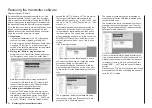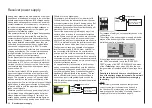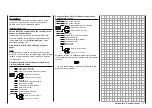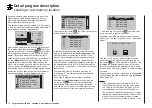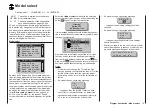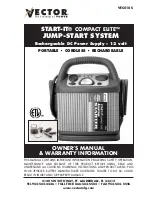
66
Term definitions
Definitions of terms
Control function, control, function input, control channel, mixer, kind of switches
To make use of this manual easier, a number of the
terms used repeatedly throughout this manual have
been defined below.
Control function
A “control function” is to be perceived – initially inde-
pendent of its signal path – as a signal intended to
affect a given control function. For example, this could
be for throttle, rudder or aileron in a winged aircraft or
pitch, roll or crow for a helicopter.
A control function signal can be applied directly over
a single control channel or also through a mixer and
then applied over multiple control channels. A typical
example of multiple control channels is separately
operated aileron servos or the use of two roll or crow
servos in helicopters. The control function explicitly in-
cludes the influence of the control’s mechanical travel
on the respective servo. This can not only be spread
or compressed by software but even the travel char-
acteristic can be modified from linear to extremely
exponential.
Control
“Controls” include all operating elements on the trans-
mitter, which are directly activated by the pilot, that
impose an effect on servos, speed controllers etc.
connected to the receiver. This includes:
• both sticks for control functions 1 through 4,
whereby these four functions can be freely
swapped around for both model types (“winged
aircraft” and “helicopters”) by way of software
“Mode” settings, e. g. throttle left or right. The stick
function for throttle/airbrake control at “winged
aircraft” or throttle/pitch control at “helicopters” is
often also referred to as the C1 control (channel
1).
• both proportional controls located on the trans-
mitter’s sides, which are, for example, given the
de signations Lv1 (left-side “rotary slider”) and Lv2
(right-side “rotary slider”) in the »Control adjust«
• the two INC/DEC buttons, which are fitted on both
sides of the front screen on the
mc-20
HoTT
transmitter only. These are typically labelled Cn5
and 6 in the »Control adjust« menu; see sections
starting on page 118 and 122.
If they are assigned as transmitter controls in the
»Control adjust« menu, these buttons can be
used to move a servo in 1 % increments relative
to the servo travel currently set (as selected in the
»Servo adjustment« menu.) When you press one
of the INC/DEC buttons, the positions are briefly
superimposed on the base display.
They are ideal for tasks such as setting flight
phase specific flap positions and similar fine trim-
ming. If a button is held pressed in, the rate of
change automatically speeds up – indicated by a
faster sequence of audible beeps; a different beep
indicates the centre position. Since you can opt for
the (trim) position of these two transmitter controls
to be stored separately for each flight phase – pro-
vided that they have been assigned to one of the
inputs 5 … 12 in the “Control adjust” menu – you
can use one and the same INC/DEC button in the
same way for all flight phases you may have pro-
grammed. This does not apply to position-depend-
ent proportional transmitter controls.
• the two proportional sliders in the middle console
designated Sl1 and 2, for example as shown in the
»Control adjust« menu, page 118 and 122,
• the switches present, if they are assigned to a
control channel in the »Control adjust« menu.
The proportional operating elements produce a direct
effect on servos which is commensurate with the con-
trol’s position whereas switch modules can only effect
a two or three increment change.
Just which of these controls and switches operate
which of the servos 5 … 8 respectively 5 … 12 is
freely programmable.
Important notice:
The transmitter is supplied with default program-
ming in which certain inputs are “free”, i. e. not yet
assigned to any function. These inputs are: 5 … 7
(
mc-16
) and 5 … 11 (
mc-20
only as standard)
for model helicopters, and 5 … 8 (
mc-16
) and 5
… 12 (
mc-20
only as standard) for fixed-wing
model aircraft.
Function input
This is an imaginary point in the signal path and must
not be considered the same as the point on the circuit
board where the transmitter control is connected. The
choice of “Stick mode” and settings in the »Con-
trol adjust« menu have their effect “downstream” of
these imaginary connection points. Thus differences
between the physical control’s number and the num-
ber of the downstream control channel can indeed
emerge.
Control channel
From the point at which a signal contains all control
information necessary for a particular servo – whether
directly from the physical control or indirectly by way
of a mixer – the term “control channel” is used.
(For example, for a fixed-wing model aircraft set up
as the model type “2AIL”, this means that the “Aileron”
control function is divided into the control channels
left and right aileron. Similarly: for a helicopter set up
as the “3Sv(2roll)” type, the “Roll” control function is
split into the control channels left and right roll servo.)
The signal of this type of control channel can only
be further influenced by the settings entered in the
»Servo adjustment« menu (and in the »Tx. output
swap« menu, which is available in the
mc-20
HoTT transmitter only, but can be unlocked in the
mc-16
HoTT transmitter); the signal then leaves the
transmitter via the RF module.
Once it arrives at the receiver, this signal may still be
modified by settings made in the »Telemetry« menu
Summary of Contents for HoTT MC-16 Series
Page 1: ...Programming Manual mc 16 mc 20 HoTT 1 en mc 16 mc 20...
Page 27: ...27 For your notes...
Page 53: ...53 For your notes...
Page 61: ...61 For your notes...
Page 65: ...65 For your notes...
Page 71: ...71 For your notes...
Page 103: ...103 For your notes...
Page 107: ...107 For your notes...
Page 111: ...111 For your notes...
Page 155: ...155 For your notes...
Page 165: ...165 For your notes...
Page 201: ...201 For your notes...
Page 229: ...229 For your notes...
Page 231: ...231 For your notes...
Page 261: ...261 For your notes...
Page 265: ...265 For your notes...
Page 301: ...301 For your notes...
Page 327: ...327 For your notes...
Page 328: ...328 For your notes...

